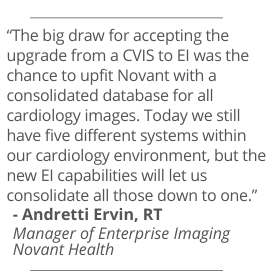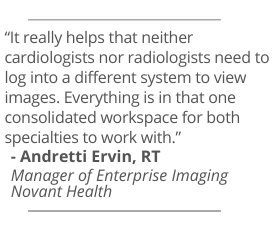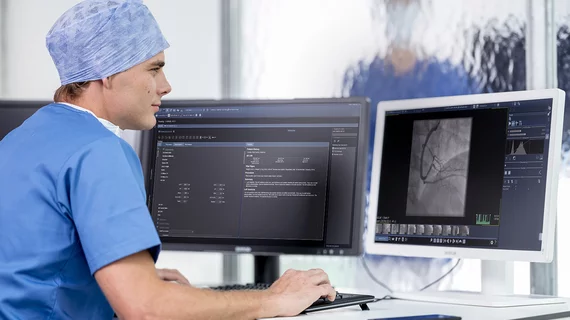Novant Health Brings Cardiology into Agfa HealthCare's Enterprise Imaging
As recently as eight months ago, cardiologists sitting down to work with medical images at Novant Health had plenty of choices on where and how to go about that part of their jobs.
In fact, they had too many choices. Whether the job at hand involved viewing, storing, retrieving or reporting—or all of the above—the physicians had to navigate data siloes that had sprung up and proliferated across several cardiology practices serving the Southeast U.S. through the 15-hospital health system.
By the middle of 2019, Novant Health’s cardiology imaging processes were “all over the place.” So recalls Andretti Ervin, then a radiologic technologist who’s been involved with patient imaging at Novant Health for more than two decades. “The cardiologists were doing some reporting in Epic [EHR], some reporting in a third-party application for dictation, some reporting from within a legacy CVIS. Just all over the place.”
That was then and this is now. As Novant Health’s manager of enterprise imaging, Ervin today oversees the “EI” arena for radiology as well as cardiology.
His job title offers a clue as to what changed in Novant Health’s cardiology operations as of last autumn.
 “The big draw for accepting the upgrade from a CVIS to EI was the chance to upfit Novant with a consolidated database for all cardiology images,” Ervin recalls. “Today we still have five different systems within our cardiology environment, but the new EI capabilities will let us consolidate all those down to one.”
“The big draw for accepting the upgrade from a CVIS to EI was the chance to upfit Novant with a consolidated database for all cardiology images,” Ervin recalls. “Today we still have five different systems within our cardiology environment, but the new EI capabilities will let us consolidate all those down to one.”
Along with consolidate, the other operative word might be upgrade. Novant didn’t grapple with which vendor would supply its cardiological EI solution. Agfa HealthCare’s systems and people had been pleasing Novant physicians and staff since the turn of the 21st century, Erving says. And among the company’s well-loved technologies was that aging CVIS. For this reason, he points out, buy-in on the upgrade to EI was both instant and unanimous. And the upgrade path was clear and well laid out.
“We’ll soon be able to have cardiac cath, echocardiography, vascular ultrasound and some nuclear medicine all in one database,” he says. “Our cardiologists will have up-to-date technology that lets them see all the images they need to see in, effectively, a single step. They won’t have to deal with imaging data siloes anymore.”
Having completed the initial leap from conventional CVIS and cardiology PACS to Agfa HealthCare EI for Cardiology, Ervin recognizes that he learned a lot along the way. In a recent Zoom interview with Cardiovascular Business, he shared observations that may be instructive for any hospital-based imaging team mulling a move toward modernization via enterprise imaging.
100% image fulfillment
Agfa HealthCare Enterprise Imaging for Cardiology is rolling out in phases at Novant Health, which is based in North Carolina and operates nearly 700 locations across four states. The first part of the implementation went live in early November.
Within two weeks of making the switch, the first of four cardiology groups in line started asking Ervin’s team how soon they’d be able to add their noninvasive images, meaning the rest of their imaging data upstreaming to EI.
“They were just that pleased right off the bat,” Ervin says. “I actually had to slow people down and remind them we hadn’t even completed this part of the implementation for our other three cardiology groups. As soon as they saw the functionality of the EI platform approach, they were champing at the bit to get more of it.”
A major point of the immediate satisfaction came with easily sharing image access with clinical colleagues outside of cardiology. Ervin notes this collaboration-supporting aspect owes to the zero-footprint viewer that’s native to Agfa EI for Cardiology.
“You don’t have to go in and make a special download to be able to view the images,” he says. “That was a challenge with the old system. You probably had a 40% chance that you could click on the link from within the EHR, open the images and be able to view them successfully.”
And now? “You’ve got a 100% chance,” Ervin replies. “Physicians click on those image links and can now reliably view cardiology images all the way back to 2000.”
Physicians on board
The general benefits of the enterprise platform approach are further enhanced by some specific features of Agfa EI for Cardiology, Ervin says. He singles out for special plaudits the capability the system affords cardiologists to work with volume renderings.
“When they want to go in and measure something within the heart, they have better tools inside the EI system than they ever had before,” he says. “They’ve commented that we’re lightyears ahead of where we were with our prior product.”
Because the physicians offered this feedback spontaneously, Ervin notes, he’s reassured almost daily how good a decision the upgrade is proving to be.
“When we hear anything, it really all comes down to modernizing our cardiology service lines,” he says. “Plus, being able to take advantage of tools from a cardiology perspective has been huge for the whole institution.”
As an example of this effect in action, Ervin cites the migration of echocardiography and vascular images out of the old system and into Agfa EI for Cardiology.
“If a patient has been to the cath lab but also had an imaging study done since then to measure a carotid artery or something like that, the physician can get a complete view from all those images in our one EI platform,” he says. “That has been the biggest portion where we really didn’t have to work to get buy-in on the EI system. Once we brought all the pieces together and the physicians could see each patient’s longitudinal record, including images, they bought in instantly.”
COVID-ready collaborations
Being able to catch up Novant Health’s cardiology specialists with their peers in radiology has paved the way to better interdepartmental relations, Erving has observed.
“Because that image link is now right there in our EHR, the radiologists are able to see the images that were obtained in a cardiology space. And cardiologists can view the images that came from a radiology space,” he notes. “We didn’t have that before. From a continuum-of-care perspective, it’s about extending access for viewing images to every clinician who needs that access.”
Perhaps never in Novant Health’s history was the facilitation of multidisciplinary collaboration more important than it has become during the COVID-19 crisis, Ervin agrees. This may be especially key for radiology and cardiology, as both the heart and lungs can be significantly affected with COVID.
 “It really helps that neither cardiologists nor radiologists need to log into a different system to view images,” Ervin says. “Everything is in that one consolidated workspace for both specialties to work with.”
“It really helps that neither cardiologists nor radiologists need to log into a different system to view images,” Ervin says. “Everything is in that one consolidated workspace for both specialties to work with.”
This comprehensive access to images even extends to physicians working from home due to the COVID pandemic. “If they need to remotely view images or do a preliminary report—or even if they need to consult a patient in an exam room within Novant Health—they’re able to do all of that,” Ervin says. “And that’s regardless of where they are.”
What’s more, diagnostic imaging teams can work this way with the volume renderings. “They have a drawing, and they have the images to go along with the drawing,” he says. “This gives the patient as well as the cardiologist a very clear view of what’s going on within the patient’s cardiovascular system”—a crucial aid to decision-making for patients with both COVID-19 and cardiovascular comorbidities.
Good for business
In his role as manager of EI, Ervin has to keep his eye on the fiscal side of enterprise imaging. He says assessing the ROI of the upgrade to Agfa EI for Cardiology entails seeing this discrete process in the context of its place in the EHR, as this is where billing gets generated at Novant.
Viewed from this perspective, the move to the EI platform is enabling the institution to take its cardiologists live with both a new imaging system and a new reporting system at the same time.
And this means the EI component is allowing cardiology administrators to streamline billing.
“We’ve helped consolidate the cardiologists’ workflow so that the way they generate revenue is standardized across four different markets,” Ervin says. “Every cardiologist views images, files clinical reports and does everything else in one highly efficient way across our entire enterprise.”
More service lines and a VNA ahead
Looking ahead, Ervin is counting on Novant’s relationship with Agfa HealthCare to build on the momentum created by the EI for Cardiology project as it rolls toward completion.
“Because of what we’ve been able to accomplish together so far, and having worked through some cultural differences along the way, Novant and Agfa are on really solid ground,” he says. Eventually the institution wants to extend enterprise imaging to departments capturing clinical photos and videos, he notes, such as surgery, pathology, dermatology, ophthalmology, wound care and forensics.
“Moving all of those onto a better platform will be really great,” Ervin says. “We’re already in the initial phase of implementing a plan on a vendor-neutral archive that will house all those non-DICOM images.”
In the shorter term, he’s looking forward to the end of July, when EI for Cardiology will begin adding the noninvasive images. “It’s a bigger subset of images and a bigger subset of workflows,” Ervin explains.
That’s a bit of an understatement. The initial rollout brought in 10 Novant facilities. The noninvasive phase will affect around 65 sites.
“We hope to have all that done by the end of August,” Ervin says, adding his confidence in Agfa EI for Cardiology is high because, to date, “it’s been rock solid in helping us move ahead into enterprise imaging. I’m definitely excited about the future.”
To learn how Agfa HealthCare Enterprise Imaging for Cardiology can drive your health system’s clinical, business, and operational strategies, click here.

